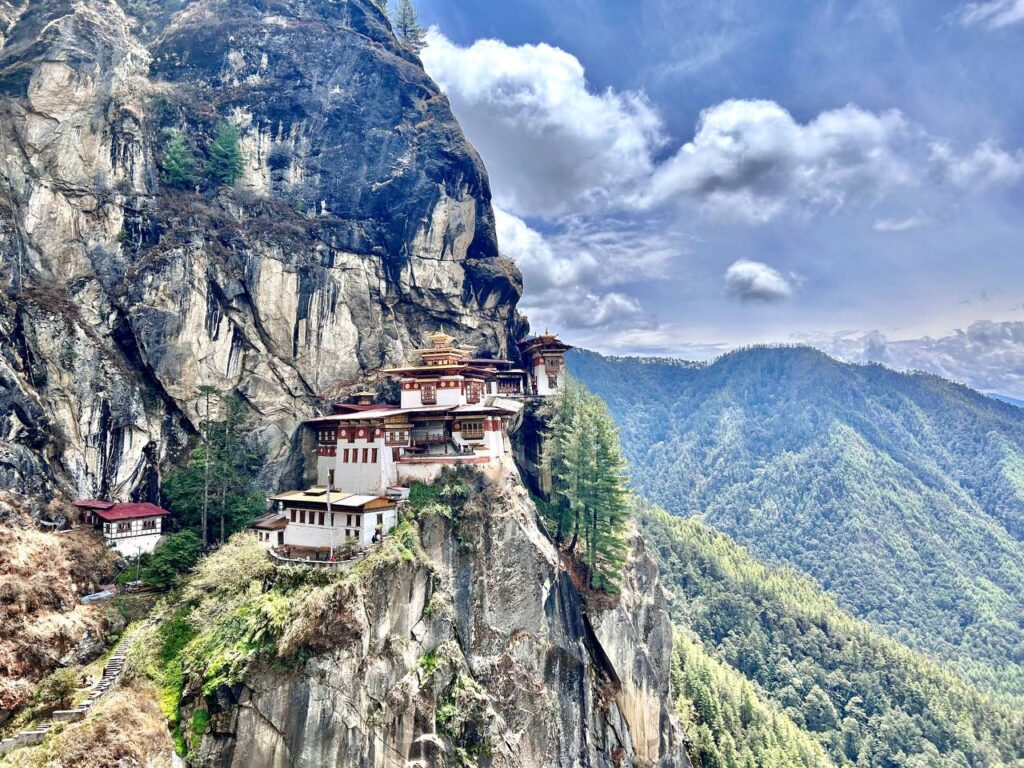Tiger's Nest Monastery: Bhutan’s Mystical Jewel in the Clouds
Nestled precariously on a sheer cliffside at an elevation of 3,120 meters (10,240 feet), Tiger’s Nest Monastery, or Paro Taktsang, is a marvel of spiritual devotion and architectural ingenuity. This iconic site is not just a place of worship but a testament to Bhutan’s deep cultural heritage and its harmonious coexistence with nature.


The Enchanting Legend of Taktsang
The monastery derives its name from a fascinating legend. It is believed that in the 8th century, Guru Padmasambhava, the revered Buddhist master, flew to this spot from Tibet on the back of a tigress to subdue a malevolent demon. He meditated in a cave here for three years, three months, three weeks, and three days, consecrating the area as a sacred site. The cave remains a centerpiece of the monastery, imbuing it with profound spiritual significance.


An Architectural Masterpiece
Constructed in 1692 by Tenzin Rabgye, the fourth Druk Desi (head of state), the monastery is a feat of engineering. Perched on a cliff that drops nearly 900 meters into the Paro Valley below, its whitewashed walls, golden roofs, and red-painted wooden balconies blend seamlessly into the rugged terrain. Despite its seemingly precarious location, the monastery exudes a sense of serenity and permanence.
Inside, intricately painted murals, flickering butter lamps, and statues of Buddhist deities create an atmosphere of transcendence. The smell of incense wafting through the chambers enhances the mystical ambiance.
The Pilgrimage of a Lifetime
Reaching Tiger’s Nest is a journey as transformative as the destination. The hike begins at the base of the Paro Valley, winding through lush pine forests adorned with prayer flags fluttering in the wind. The trail, though challenging, offers panoramic views of the valley, with glimpses of the monastery teasing hikers from afar.
The halfway point brings you to a small café, offering a much-needed respite and stunning vistas. As you ascend further, the sound of distant waterfalls and the rustling of leaves create a meditative rhythm. The final stretch, a steep climb of stone steps, demands effort but rewards you with an unparalleled sense of accomplishment.

Spiritual Significance and Festivals
Tiger’s Nest is a revered pilgrimage site for Buddhists worldwide. It is particularly vibrant during the Tsechu festival, celebrated in honor of Guru Padmasambhava. The monastery comes alive with masked dances, traditional music, and rituals that attract devotees and tourists alike.
Tips for Travelers
- Preparation: The hike requires moderate fitness. Wear sturdy shoes, carry water, and be mindful of the altitude.
- Best Time to Visit: Spring (March to May) and autumn (September to November) offer the most pleasant weather and clear views.
- Respect the Culture: Dress modestly and adhere to the monastery’s rules, including the prohibition of photography inside sacred areas.
- Permit Requirement: Foreign tourists must obtain a special permit to visit Tiger’s Nest, which can be arranged through Bhutanese tour operators.
A Timeless Symbol of Bhutan’s Soul
Tiger’s Nest Monastery is more than a destination; it’s an experience that stirs the soul and inspires the spirit. Whether you are drawn by its legendary history, its breathtaking beauty, or the sense of peace it offers, a visit here is bound to leave an indelible mark on your heart.
For travelers seeking a blend of adventure, spirituality, and cultural immersion, Tiger’s Nest stands as a beacon, inviting you to lose yourself in its mystical embrace
